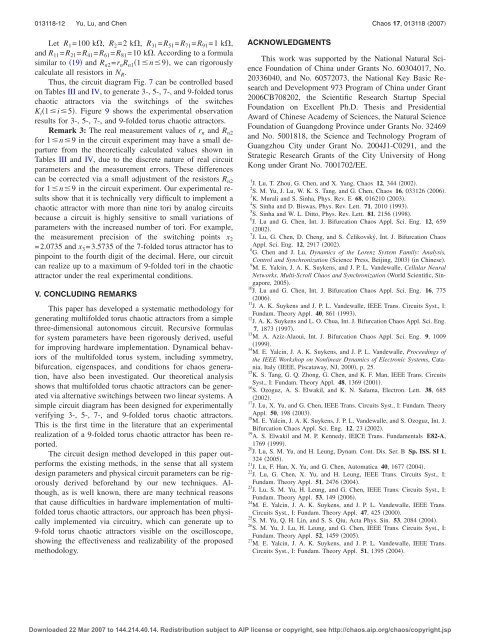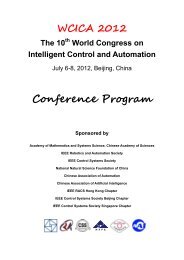Multifolded torus chaotic attractors: Design and implementation
Multifolded torus chaotic attractors: Design and implementation
Multifolded torus chaotic attractors: Design and implementation
Create successful ePaper yourself
Turn your PDF publications into a flip-book with our unique Google optimized e-Paper software.
013118-12 Yu, Lu, <strong>and</strong> Chen Chaos 17, 013118 2007<br />
Let R 1 =100 k, R 2 =2 k, R 31 =R 51 =R 71 =R 91 =1 k,<br />
<strong>and</strong> R 11 =R 21 =R 41 =R 61 =R 81 =10 k. According to a formula<br />
similar to 19 <strong>and</strong> R n2 =r n R n1 1n9, we can rigorously<br />
calculate all resistors in N R .<br />
Thus, the circuit diagram Fig. 7 can be controlled based<br />
on Tables III <strong>and</strong> IV, to generate 3-, 5-, 7-, <strong>and</strong> 9-folded <strong>torus</strong><br />
<strong>chaotic</strong> <strong>attractors</strong> via the switchings of the switches<br />
K i 1i5. Figure 9 shows the experimental observation<br />
results for 3-, 5-, 7-, <strong>and</strong> 9-folded <strong>torus</strong> <strong>chaotic</strong> <strong>attractors</strong>.<br />
Remark 3: The real measurement values of r n <strong>and</strong> R n2<br />
for 1n9 in the circuit experiment may have a small departure<br />
from the theoretically calculated values shown in<br />
Tables III <strong>and</strong> IV, due to the discrete nature of real circuit<br />
parameters <strong>and</strong> the measurement errors. These differences<br />
can be corrected via a small adjustment of the resistors R n2<br />
for 1n9 in the circuit experiment. Our experimental results<br />
show that it is technically very difficult to implement a<br />
<strong>chaotic</strong> attractor with more than nine tori by analog circuits<br />
because a circuit is highly sensitive to small variations of<br />
parameters with the increased number of tori. For example,<br />
the measurement precision of the switching points x 2<br />
=2.0735 <strong>and</strong> x 3 =3.5735 of the 7-folded <strong>torus</strong> attractor has to<br />
pinpoint to the fourth digit of the decimal. Here, our circuit<br />
can realize up to a maximum of 9-folded tori in the <strong>chaotic</strong><br />
attractor under the real experimental conditions.<br />
V. CONCLUDING REMARKS<br />
This paper has developed a systematic methodology for<br />
generating multifolded <strong>torus</strong> <strong>chaotic</strong> <strong>attractors</strong> from a simple<br />
three-dimensional autonomous circuit. Recursive formulas<br />
for system parameters have been rigorously derived, useful<br />
for improving hardware <strong>implementation</strong>. Dynamical behaviors<br />
of the multifolded <strong>torus</strong> system, including symmetry,<br />
bifurcation, eigenspaces, <strong>and</strong> conditions for chaos generation,<br />
have also been investigated. Our theoretical analysis<br />
shows that multifolded <strong>torus</strong> <strong>chaotic</strong> <strong>attractors</strong> can be generated<br />
via alternative switchings between two linear systems. A<br />
simple circuit diagram has been designed for experimentally<br />
verifying 3-, 5-, 7-, <strong>and</strong> 9-folded <strong>torus</strong> <strong>chaotic</strong> <strong>attractors</strong>.<br />
This is the first time in the literature that an experimental<br />
realization of a 9-folded <strong>torus</strong> <strong>chaotic</strong> attractor has been reported.<br />
The circuit design method developed in this paper outperforms<br />
the existing methods, in the sense that all system<br />
design parameters <strong>and</strong> physical circuit parameters can be rigorously<br />
derived beforeh<strong>and</strong> by our new techniques. Although,<br />
as is well known, there are many technical reasons<br />
that cause difficulties in hardware <strong>implementation</strong> of multifolded<br />
<strong>torus</strong> <strong>chaotic</strong> <strong>attractors</strong>, our approach has been physically<br />
implemented via circuitry, which can generate up to<br />
9-fold <strong>torus</strong> <strong>chaotic</strong> <strong>attractors</strong> visible on the oscilloscope,<br />
showing the effectiveness <strong>and</strong> realizability of the proposed<br />
methodology.<br />
ACKNOWLEDGMENTS<br />
This work was supported by the National Natural Science<br />
Foundation of China under Grants No. 60304017, No.<br />
20336040, <strong>and</strong> No. 60572073, the National Key Basic Research<br />
<strong>and</strong> Development 973 Program of China under Grant<br />
2006CB708202, the Scientific Research Startup Special<br />
Foundation on Excellent Ph.D. Thesis <strong>and</strong> Presidential<br />
Award of Chinese Academy of Sciences, the Natural Science<br />
Foundation of Guangdong Province under Grants No. 32469<br />
<strong>and</strong> No. 5001818, the Science <strong>and</strong> Technology Program of<br />
Guangzhou City under Grant No. 2004J1-C0291, <strong>and</strong> the<br />
Strategic Research Grants of the City University of Hong<br />
Kong under Grant No. 7001702/EE.<br />
1 J. Lu, T. Zhou, G. Chen, <strong>and</strong> X. Yang, Chaos 12, 344 2002.<br />
2 S. M. Yu, J. Lu, W. K. S. Tang, <strong>and</strong> G. Chen, Chaos 16, 033126 2006.<br />
3 K. Murali <strong>and</strong> S. Sinha, Phys. Rev. E 68, 016210 2003.<br />
4 S. Sinha <strong>and</strong> D. Biswas, Phys. Rev. Lett. 71, 2010 1993.<br />
5 S. Sinha <strong>and</strong> W. L. Ditto, Phys. Rev. Lett. 81, 2156 1998.<br />
6 J. Lu <strong>and</strong> G. Chen, Int. J. Bifurcation Chaos Appl. Sci. Eng. 12, 659<br />
2002.<br />
7 J. Lu, G. Chen, D. Cheng, <strong>and</strong> S. Čelikovský, Int. J. Bifurcation Chaos<br />
Appl. Sci. Eng. 12, 2917 2002.<br />
8 G. Chen <strong>and</strong> J. Lu, Dynamics of the Lorenz System Family: Analysis,<br />
Control <strong>and</strong> Synchronization Science Press, Beijing, 2003 in Chinese.<br />
9 M. E. Yalcin, J. A. K. Suykens, <strong>and</strong> J. P. L. V<strong>and</strong>ewalle, Cellular Neural<br />
Networks, Multi-Scroll Chaos <strong>and</strong> Synchronization World Scientific, Singapore,<br />
2005.<br />
10 J. Lu <strong>and</strong> G. Chen, Int. J. Bifurcation Chaos Appl. Sci. Eng. 16, 775<br />
2006.<br />
11 J. A. K. Suykens <strong>and</strong> J. P. L. V<strong>and</strong>ewalle, IEEE Trans. Circuits Syst., I:<br />
Fundam. Theory Appl. 40, 861 1993.<br />
12 J. A. K. Suykens <strong>and</strong> L. O. Chua, Int. J. Bifurcation Chaos Appl. Sci. Eng.<br />
7, 1873 1997.<br />
13 M. A. Aziz-Alaoui, Int. J. Bifurcation Chaos Appl. Sci. Eng. 9, 1009<br />
1999.<br />
14 M. E. Yalcin, J. A. K. Suykens, <strong>and</strong> J. P. L. V<strong>and</strong>ewalle, Proceedings of<br />
the IEEE Workshop on Nonlinear Dynamics of Electronic Systems, Catania,<br />
Italy IEEE, Piscataway, NJ, 2000, p.25.<br />
15 K. S. Tang, G. Q. Zhong, G. Chen, <strong>and</strong> K. F. Man, IEEE Trans. Circuits<br />
Syst., I: Fundam. Theory Appl. 48, 13692001.<br />
16 S. Ozoguz, A. S. Elwakil, <strong>and</strong> K. N. Salama, Electron. Lett. 38, 685<br />
2002.<br />
17 J. Lu, X. Yu, <strong>and</strong> G. Chen, IEEE Trans. Circuits Syst., I: Fundam. Theory<br />
Appl. 50, 198 2003.<br />
18 M. E. Yalcin, J. A. K. Suykens, J. P. L. V<strong>and</strong>ewalle, <strong>and</strong> S. Ozoguz, Int. J.<br />
Bifurcation Chaos Appl. Sci. Eng. 12, 232002.<br />
19 A. S. Elwakil <strong>and</strong> M. P. Kennedy, IEICE Trans. Fundamentals E82-A,<br />
1769 1999.<br />
20 J. Lu, S. M. Yu, <strong>and</strong> H. Leung, Dynam. Cont. Dis. Ser. B Sp.ISS.SI1,<br />
324 2005.<br />
21 J. Lu, F. Han, X. Yu, <strong>and</strong> G. Chen, Automatica 40, 1677 2004.<br />
22 J. Lu, G. Chen, X. Yu, <strong>and</strong> H. Leung, IEEE Trans. Circuits Syst., I:<br />
Fundam. Theory Appl. 51, 2476 2004.<br />
23 J. Lu, S. M. Yu, H. Leung, <strong>and</strong> G. Chen, IEEE Trans. Circuits Syst., I:<br />
Fundam. Theory Appl. 53, 149 2006.<br />
24 M. E. Yalcin, J. A. K. Suykens, <strong>and</strong> J. P. L. V<strong>and</strong>ewalle, IEEE Trans.<br />
Circuits Syst., I: Fundam. Theory Appl. 47, 4252000.<br />
25 S. M. Yu, Q. H. Lin, <strong>and</strong> S. S. Qiu, Acta Phys. Sin. 53, 2084 2004.<br />
26 S. M. Yu, J. Lu, H. Leung, <strong>and</strong> G. Chen, IEEE Trans. Circuits Syst., I:<br />
Fundam. Theory Appl. 52, 1459 2005.<br />
27 M. E. Yalcin, J. A. K. Suykens, <strong>and</strong> J. P. L. V<strong>and</strong>ewalle, IEEE Trans.<br />
Circuits Syst., I: Fundam. Theory Appl. 51, 1395 2004.<br />
Downloaded 22 Mar 2007 to 144.214.40.14. Redistribution subject to AIP license or copyright, see http://chaos.aip.org/chaos/copyright.jsp













